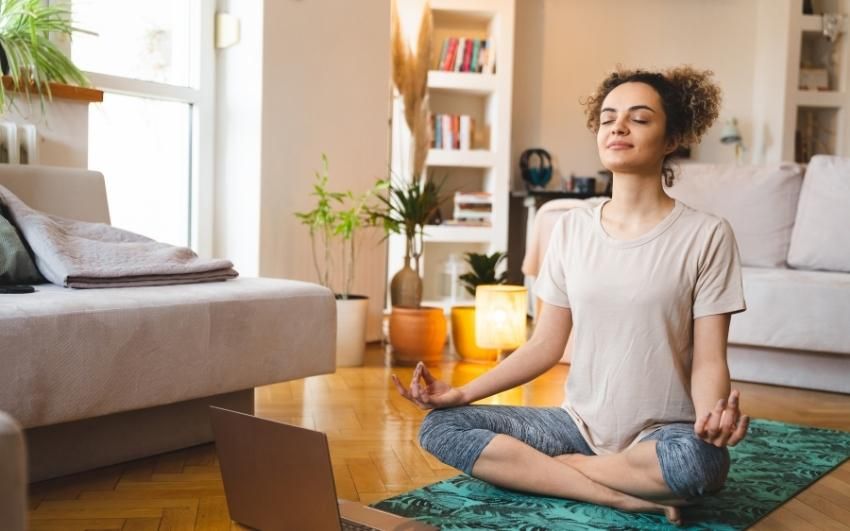
I’ve been asked to write an article about what it is like to be in a mindful state for 5 minutes. To me this feels like asking someone who experiences colors what red looks like.
All I can do is try to describe the feeling.
Like Drunvalo Melchizedek I feel that a life without this feeling is a life not worth living.
I was first introduced to it through yoga, which led me to other practices such as Qi Gong and meditation.
The best way to describe what I see/feel is that the mind opens up into a sort of infinite space with stars scattered about as though from some cosmic explosion.
Table of Contents
The definition of mindfulness
Mindfulness is the fundamental human ability to be fully present, aware of our surroundings and activities, and not overly reactive or overwhelmed by what’s going on around us.
Mindfulness is a natural quality that everyone has, and it’s not something you have to manufacture.
All you have to do is learn how to do it.
The advantages of practicing mindfulness:

When we meditate, it’s not enough to focus on the advantages:
- We should simply perform the practice and yet there are benefits or no one would do it.
- We can achieve these benefits by being attentive when we are conscious.
- We may decrease stress and improve performance, gain insight and awareness into our own mind, and focus on the wellbeing of others.
Mindfulness meditation allows us to set aside judgment and let our natural curiosity about the mind’s workings guide us as we encounter life with warmth and compassion—to ourselves and others.
Practicing mindfulness:
1. What is mindfulness and how can it help you live a better life?

Mindfulness is the psychological process of bringing one’s attention to experiences occurring in the present moment, which can be developed through the practice of meditation and other training.
It has been popularized in Western cultures by Jon Kabat-Zinn who founded an eight-week MBSR program at the University of Massachusetts Medical School.
2. How to be mindful in your everyday life

If you want to have the ability to be mindful, you have to practice it. Mindfulness is a habit that one can build by bringing attention and awareness into your daily life.
Once you have got a grasp on what mindfulness is you can try to incorporate it into your daily life. To do this, simply bring awareness from time to time when doing things that you do unconsciously, such as driving a car.
Mindfulness is the state of being aware of yourself and your surroundings in a moment-to-moment way.
3. The benefits of mindfulness

The benefits of mindfulness are endless. Mindfulness can help with relieving stress, improving focus and mood, depression, high blood pressure, maths skills, giving you a sense of purpose and helping with sleep which are just a few of the many benefits.
It also increases your ability to focus and makes you more aware of emotions/feelings that may be affecting how you act towards others.
4. How to meditate for beginners

You don’t have to be a monk or sit in the lotus position to meditate.
Meditation is a powerful tool for calming your mind, reducing stress and anxiety levels to improve sleep patterns. It’s also been shown in studies that people who meditate have less stress symptoms when compared with those who don’t practice mental relaxation techniques like meditation or yoga!
Use an alarm clock to set 10 minutes for meditation. Set it as far away as possible so you’re not tempted to just press snooze and go back to sleep!
Here are some ways that you can start meditating today:
1. Try taking five minutes at first thing tomorrow morning before working/ exercising etc., just let go of any thoughts on what needs done around the house (or office), close eyes & focus only inwardly while breathing deeply-in through nose exhaling fully out without pushing air waves away from body;
2. Do this again after lunchtime during work hours–heck knows we all need more downtime anyway ;
3. Try another session at bedtime, make a habit of it-& see how you do on any given day–doing the work to increase positive energy flow is always worth it!
You can get in at least 15 minutes of mindfulness practice every day.
In a study sponsored by the Benson-Henry Institute for Mind Body Medicine at Massachusetts General Hospital, Dr. James E. Stahl and his team of Harvard researchers studied participants who had undergone an 8-week mind-body relaxation course given through the institute.
The curriculum included a variety of mind-body skills.
Dr. Stahl, who is now at Dartmouth-Hitchcock Medical Center, teaches his own patients mindfulness and meditation techniques in his internal medicine practice and encourages others to do so regularly.
He believes that you don’t have to join a formal course or spend much time practicing. 10 to 15 minutes each day is all it takes, he claims.
Consistency is the key.
Here are a few examples of how to use mindfulness techniques in your daily routine:
Begin your day with a basic Sun Salutation yoga sequence:
If you’re a novice, try the instructions outlined below and demonstrated in this video.
Step back into Plank pose one foot at a time, instead of jumping back.
Drop your knees to the floor in Low Plank (Four-limbed Staff) Pose to support and build your core muscles.
Substitute Cobra Pose instead of Upward Facing Dog Pose for the first few salutation cycles to warm up your lower back.
At the end of your day, unwind with a 15-minute guided meditation.
Keep guided meditations or podcasts on your phone or tablet so they’re always accessible.
Guided meditations are available through:
- Apps like Headspace (link)
- Meditation Oasis Podcast (link)
- The UCLA Mindful Awareness Research Center (link)
- The Chopra Center (link)
- Meditation teachers like Tara Brach (link)
Check in with your breath for 10 to 15 minutes for a midday break. Close your eyes and notice where you store stress in your body. As your breath becomes slower and smoother, imagine sending your breath to that area on your inhalation. Imagine a knot loosening as you exhale. Repeat this cycle with each inhalation and exhalation.
Do a body scan for 10 to 15 minutes. Find a comfortable seat or lie down. Close your eyes and breathe more deeply and slowly. First, focus your attention on your feet. Notice any tension, pain, or stress. Take deep, slow breaths as you focus your awareness on that area of your body. As if you are scanning your body with light, move your attention slowly upward. Notice how each section of your body feels as you continue to breathe slowly: your shins and knees, thighs and hips, lower back and abdomen, chest and upper back, neck and shoulders, and finally your head.
Try a variety of approaches to find what sticks. Daily practice works best, but if you have a busy schedule, aim to practice at least three or four times a week. And don’t give up if you feel like it’s not working right away. These techniques are like any other skill or workout — the more you do it, the stronger you will get.
5. Other mindfulness exercises you can do every day
Mindful reading
Mindful reading is a meditation technique in which you pay attention to the words on your page. You can do this by focusing solely upon them, not paying any mind as if they were background noise or something else that doesn’t deserve notice – just let these letters flow through their normal cycle without interruption from other thoughts/thoughts patterns while maintaining an calm mood environment because our brains LOVE predictability! So when faced with uncertainty try rereading part way down sentence slowly then moving onto next one until finally finishing off right away before anything else distracts us too much…
Mindful writing
Mindful writing is a form of creative nonfiction that combines elements from the worlds religions, psychology and mindfulness with an examination on how they relate to one another.
Mindfulness has been emerging as something people are taking up more often these days; especially in relation what we’re going through right now because it helps us manage our emotions better which ultimately leads towards less stress-related health problems such as insomnia or high blood pressure.
Mindful listening
Mindful listening is the act of truly hearing what a person has to say without interruption, judgment or bias. It’s about paying attention so that you can really hear their concerns and understand where they are coming from–it could be difficult at first but with practice it gets easier!
Mindfulness and visualization
What strategy are you using to have more peace of mind?
Are you meditating for peace of mind?
Or are you combining meditation with effective visualization to manifest your desires?
The law of attraction and manifesting works best for people who can visualize in the state of meditation.
If you are looking to manifest more success, you have to imagine that moment in your mind.
To visualize every part of it:
- How does it look around you?
- Can you touch and feel the surroundings.
- Can you smell something?
- What do you feel at this moment?
Visualizing is not easy and for most people.
The process of visualization requires a lot of mind power.
Time by yourself
It’s about shutting away the outside.
Focusing your mind on one thing and one thing alone.
Approx. 15 or 20 minutes.
This requires a lot of practice and that is why the law of attraction meditation is so effective.
Why Is Meditation Important In The Law Of Attraction?
The idea of meditating as part of manifestation has a lot of benefits.
However, the most important one is that it trains your mind to focus.
FOCUS.
There are so many distractions in life some of which arise from the kind of negativity we have to deal with each day.
Shutting out that negativity and those distractions will need proper meditation.
If you are able to learn how to meditate properly, you will realize that even when you are visualizing your mind does not wander around.
The law of attraction meditation helps you to become a better person in visualizing and if you are better in visualizing, you increase the chances of manifestation significantly.
How To Meditate In The Law Of Attraction
Meditation as a technique takes time to learn but with daily practice, you will be very good in no time.
The following are a few meditation tips that will help you get the results you are looking for:
Practice
The first thing you need to meditate properly is to practice.
If you are a beginner, there is no need to try something complex.
Just give yourself ten minutes twice a week to sit in a quiet place, close eyes, and focus on anything.
Ideally, it’s best to add a few elements of nature.
In that case, just think yourself being in a nice little garden with blossoming flowers and a stream of fresh water running down the rocks.
Maintain that state for ten minutes and you will start to get used to it.
Clarity
When you are meditating on something, clarity is the most important thing. Every detail matters.
For example, let’s say you are meditating on a good home. Make sure you are as clear as possible in your mind of how the home looks like, the colors on the wall, the curtains, the furniture and such like small details.
Listen
Meditation is not about closing your eyes and focusing your mind on something.
It’s about listening to what is happening in your dream. For example, if you are meditating about a house, listen to the sound of the wind outside and all the sounds that it brings.
This will help you maintain focus and calm.
The law of attraction meditation is very crucial in visualization and the sooner you learn this technique the better it will be for proper manifestation.

Petri Maatta is a photographer, filmmaker, and webdesigner who has been working for over 20 years in the creative industry. Fascinated by manifesting for business reasons, Petri was determined to find out what it took to create success. He started his career with seven years of business failures before he found success by learning about manifesting from a mentor with a Fortune 500 company. Today Petri shares his knowledge through DreamMaker courses designed to help people change their businesses and lives while living on their terms.
STAY IN THE LOOP
Subscribe to our free newsletter.
Stay up to date! Get all the latest & greatest posts delivered straight to your inbox


